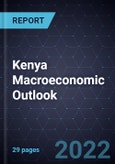Manufacturing Impetus, Affordable Housing Push, and Business-Friendly Policies to Augment Medium-Term Growth Potential
Spared of widespread coronavirus outbreaks, the Kenyan economy reported a small economic contraction in 2020 as robust growth across agriculture, financial services, real estate, and construction largely offset the sharp decline in hospitality, tourism, and transport services. The economy registered an impressive rebound in 2021, led by the broad-based recovery in the manufacturing, transport, ICT, and hospitality sectors. Despite limited direct economic linkages with Russia and Central Asia in the wake of the Russo-Ukrainian war, the country’s 2022 GDP growth faces increased headwinds in the form of soaring energy and food prices, monetary tightening, and a deteriorating fiscal position due to a mounting subsidy bill and rising debt repayment costs. Against this backdrop, how will the Kenyan economy fare in 2022 and beyond? Can business-friendly reforms, infrastructure investments, and manufacturing incentives transform Kenya into a regional trade hub in East Africa over the medium term?
This research provides an overview of Kenya’s shifting demographic and economic landscape until 2027, supported by policy measures to roll out universal healthcare, create affordable housing, and drive manufacturing growth. It examines Kenya’s economic resilience to withstand growing global headwinds by charting the impact on its GDP growth trajectory and inflation trends. In particular, the study offers insights into price pressures, supply disruptions, and interest rate movements that can help businesses undertake important sourcing and costing decisions.
This study also delineates the impact of transformative global events, including the Russo-Ukrainian war, adoption of climate-conscious policies, and ceasefire in the Tigray conflict in neighboring Ethiopia on the Kenyan economy. By analyzing Kenya’s performance on key global indices, this economic outlook highlights Kenya’s growing attractiveness as an investment hub, especially in comparison to similar economies in East Africa. The report also identifies growth opportunities arising from a confluence of policy pivots and global economic disruptions, as well as the key strategic imperatives for businesses to minimize the impact of input shortages and currency depreciation in the short term.
Key Issues Addressed
- What is Kenya’s GDP growth outlook over the next 5 years?
- Will the rapid tightening of global financial conditions result in more policy rate hikes in 2022 and beyond?
- How will higher food and fuel prices impact the inflation outlook in 2022 and beyond?
- How is Kenya adapting to upending global geopolitical disruptions such as the Russo-Ukrainian war and the Ethiopian Tigray war?
- How will Kenya’s population structure evolve over the next 5 years?
- Which sectors are poised for growth supported by medium-term policy priorities to drive economic growth?
- How will fiscal policy evolve in light of the growing external public debt repayment burden and mounting subsidy bill?
- Which factors support Kenya’s growing attractiveness as a regional manufacturing and export hub amid the growing imperative to diversify supply chains?
- How does Kenya fare on global innovation and competitiveness indices compared with other regional economies?








